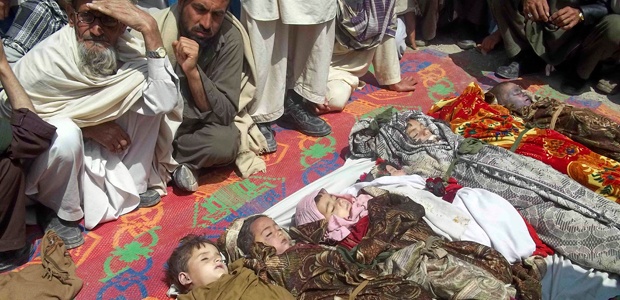Afghan Civilians

Afghan villagers sit near the bodies of children who were reported to have been killed during a NATO airstrike in Kunar province on April 7, 2013. (Photo: Reuters)
The United States war in Afghanistan continues destroying lives due to the war-induced breakdown of the economy, public health, security, and infrastructure. Afghans have been massively improverished by the conflict. 92% of the population faces some level of food insecurity and 3 million children are at risk of acute malnutrition. Some regions are currently facing famine. At least half the population is living on less than $1.90 per day.
The United States military in 2017 relaxed its rules of engagement for airstrikes in Afghanistan, which resulted in a dramatic increase in civilian casualties. From the last year of the Obama administration to the last full year of recorded data during the Trump administration, the number of civilians killed by U.S.-led airstrikes in Afghanistan increased by 330 percent.
The CIA armed Afghan militia groups to fight Islamist militants and these militias are responsible for serious human rights abuses, including extrajudicial killings of civilians.
Even in the absence of fighting, unexploded ordnance from this war and landmines from previous wars continue to kill, injure, and maim civilians. Fields, roads, and school buildings are contaminated by ordnance, which often harms children as they go about chores like gathering wood.
The war has also inflicted invisible wounds. In 2009, the Afghan Ministry of Public Health reported that fully two-thirds of Afghans suffer from mental health problems.
Prior wars and civil conflict in the country have made Afghan society extremely vulnerable to the reverberating effects of the U.S. post-9/11 war. Those war effects include elevated rates of disease due to lack of clean drinking water, malnutrition, and reduced access to health care. Nearly every factor associated with premature death — poverty, malnutrition, poor sanitation, lack of access to health care, environmental degradation — is exacerbated by the current war.
About 243,000 people have been killed in the Afghanistan/Pakistan warzone since 2001. More than 70,000 of those killed have been civilians.
Key Findings
-
As of March 2023, more than 70,000 Afghan and Pakistani civilians are estimated to have died as a direct result of the war.
-
The United States military in 2017 relaxed its rules of engagement for airstrikes in Afghanistan, which resulted in a massive increase in civilian casualties.
- The CIA has armed and funded Afghan militia groups who have been implicated in grave human rights abuses and killings of civilians.
-
Afghan land is contaminated with unexploded ordnance, which kills and injures tens of thousands of Afghans, especially children, as they travel and go about their daily chores.
-
The war has exacerbated the effects of poverty, malnutrition, poor sanitation, lack of access to health care, and environmental degradation on Afghans’ health.
Recommendations
- The U.S. government and United Nations should ensure that civilian deaths and injuries, both as a direct result of war and as an indirect consequence of violent conflict, are included in public reporting of war deaths. It should also include a tally of children killed.
- The U.S. should invest significantly more funds in clearing Afghan land of explosive hazards.
(Page updated as of March 2023)

